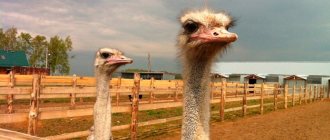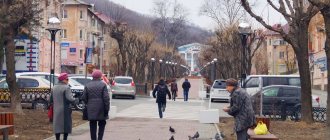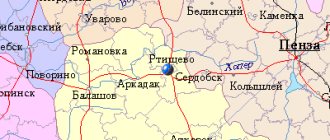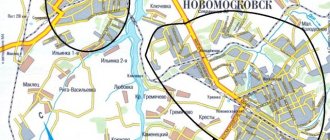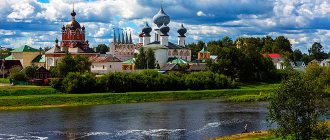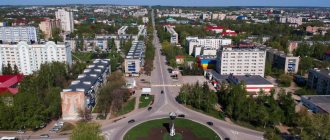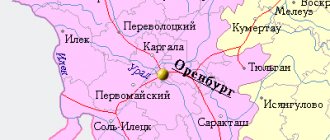Over the three hundred years of its existence, Zlatoust, founded in 1754 on the site of the Novo-Uralsky prison, managed to cover the path from a workers' village at an ironworks to a modern city. The entire fate of the policy is inextricably linked with metallurgy and its accompanying industries. It was here that the first Russian cannons were cast, and the skill of local gunsmiths, watchmakers, and metal engravers is known far beyond the borders of not only the Urals, but also the country. The sights of Zlatoust, photos and descriptions of which you will find below, are original and colorful. Factory Square in the historical part of the city, for example, is included in the register of cultural heritage sites of the Russian Federation.
Physiographic characteristics
Geographical position
Located in the European part of Russia, on the Ai River (Ufa River basin), 120 km west of the regional center of Chelyabinsk (160 km by rail) and 1,750 km east of Moscow (1,941 km by rail). The historical route of the Trans-Siberian Railway passes through the city, and the federal highway M-5 “Ural” runs near the city. The city covers an area of 118.2 km². The length from south to north is 15.4 km, from west to east 10.4 km.
Relief and geological structure
View of the historical center of the city from Mount Kosotur, 1900. In the background is the dam of the factory pond, the arms factory, the Holy Trinity Cathedral, then Mount Butylovka.
It is located in the mountainous forest part of the Chelyabinsk region, in the valley of the Ai River, formed by the mountain ranges of the Southern Urals. In the east there is the Uraltau ridge, in the west - the Urenga ridge and the Myshlyai mountains. From the north, the valley is closed by Taganay and the Nazminsky ridge. The city's topography is typically mountainous, with sharp changes in elevation.
In the center of the city, at the confluence of the Tesma River and the Ai, there is a city pond.
Climate
The climate is temperate continental. Mountains influence the climate, making it more humid and reducing the annual range of air temperatures based on monthly averages.
- average annual air temperature: +1.9 °C;
- relative air humidity: 69.2%;
- average wind speed: 3.5 m/s;
Timezone
Architecture and monuments of Zlatoust
During a tour of the city, tourists will see many ancient mansions and original buildings. Connoisseurs of monumental art will also find something to see in Zlatoust.
Arsenal building
- Address: III International Square, 1. Transport stop "TRK Agat".
The U-shaped mansion of the Arsenal, the construction of which was completed in the summer of 1833, is an important element of the architectural ensemble of the historical center of the city. The facade of the brick building is decorated with arched windows of the second tier. The central portal is slightly placed outside the main volume. In front of the entrance to the local history museum, which occupies part of the premises of the house, there are cannons cast at the local Arms Factory. Against the background of a monument of industrial architecture of the 19th century. Tourists love to take pictures.
Monument to A. Bushuev
- Address: st. Anosova. Transport stop "Railway Station".
Opposite the city railway station there is a monument to the man who glorified Zlatoust throughout Russia. The filigree works of the unsurpassed master of engraving Ivan Bushuev are included in the exhibitions of the Armory Chamber and many other foreign and domestic museums. The sculptor depicted Bushuev at the moment of creation. The master, dressed in work clothes, holds a newly made blade in his raised hand. The five-meter statue is placed on a pedestal lined with red granite.
The building of the cinema "Colosseum"
- Address: st. Kalinina, 3. Transport stop “Diagnostic Center”.
At the beginning of the last century, the inhabitants of Zlatoust showed a keen interest in the most important of the arts, according to the leader of the world revolution. Therefore, there were two cinemas operating in the city at once. However, by coincidence, a fire destroyed both wooden buildings. Then it was decided to build a new cinema, made of stone. The colorful mansion with intricate decor regularly performed educational functions until the end of the 30s of the 20th century. Later, an archive and then a supermarket were located within its walls. However, at all times the original building remained an architectural landmark of Zlatoust.
Stele "Europe - Asia"
- Address: M5 highway, eight km from Zlatoust.
This attraction is visible to all travelers traveling along the M5 highway in the direction of Miass. Eight km from Zlatoust, a stele was installed on the side of the road. It is in this place that the geographical border between Europe and Asia lies. The height of the obelisk, made of stainless steel, is about 7 m. Signs on the structure are placed so that the driver sees the name of the part of the Eurasian continent into which he is driving.
Story
Chrysostom
Holy Trinity Cathedral. View from the southwest. Approximately 1900 Monument to P.P. Anosov, Third International Square The first Russian temporary settlement on the territory of modern Zlatoust arose at the end of the 17th century in connection with the search for gold. In 1664, Elder Lot from the Dalmatovsky Assumption Monastery admitted under torture that he had made a trip to the Southern Urals, during which he was informed that gold and silver was being smelted on Lake Irtyash, mined on the “Siberian Mountain”, located in the upper reaches of Ufa, Yaika and Gadai. In 1668-1674, a large military-geological expedition was equipped, consisting of more than 1 thousand people with guns and equipment, which in 1672 built the Novo-Uralsky fort in the area of the current Taganay National Park. This fort became the first Russian settlement on the territory of the modern Chelyabinsk region. However, geological research ended in complete failure, which is stated in the chronicle in the following terms: “ Nothing was found, and great futility and destruction was caused to the sovereign’s treasury.”
" After the failure, the fort was abandoned. In 1708, the story about the “Siberian Mountain” was accidentally discovered in the documents of the Siberian Provincial Chancellery and reported to the secretary of Peter I A.D. Makarov. V.N. Tatishchev was instructed to check the information about silver ore. In the 1720s, a new expedition working near the ruins of the fort did not find metal in the local rock. In 1741, a new expedition arrived at the destroyed fort, which discovered iron ore and chose a place to build the Zlatoust plant.
In 1754, A.P. Mosolov, on patrimonial lands purchased from the Bashkirs near Mount Kosotur, founded an ironworks, which was later named in honor of St. John Chrysostom Zlatoust
. The decree of the Berg College on the construction of the plant was issued on August 31, 1754. The plant got its name due to the intentions of the owners to build a church in the name of St. John Chrysostom in the factory village, which was built in 1865. Thus, the plant received its name long before construction began. According to local historians, the image of John Chrysostom was the family icon of the family of the founder of the plant, entrepreneur A.P. Mosolov.
In 1782, the Zlatoust plant became the administrative center of the Zlatoust district of the Ufa region of the Ufa governorate. After the abolition of governorships, the village and district in 1796 administratively became part of the Orenburg province.
In 1811, the plant was bought by the state and became a state-owned plant. This led to a change in the status of the factory village, which acquired the status of a mountain town and became the economic center of the Zlatoust mountain district.
In 1824, Emperor Alexander I visited Chrysostom, and in 1857, Emperor Alexander II.
In 1865, in connection with the creation of the Ufa province, the city became part of it as the administrative center of the Zlatoust district.
In 1890, a railway station was put into operation, named Zlatoust after the name of the city near which it was built, this simplified, on the one hand, the delivery of metallurgical products of the plant and other goods, in particular, furs to the European part of the country, previously delivered by horse-drawn carts and then rafted by water. through the rivers of the Kama basin, on the other hand, it made it possible to start using fuel oil and coal from the Donetsk coal basin, instead of wood, which was depleted as a result of many years of cutting down trees. The Samara-Ufa railway was renamed the Samara-Zlatoust railway. In 1891, with the continuation of the construction of the railway to Chelyabinsk and further to the Siberian Railway, the plant began producing rail fastenings.
By 1900, the city had 2916 houses, of which 299 were stone, 8 church institutions, including one Old Believer church, a Roman Catholic church, a Protestant church, a city three-class school, 2 one-class schools (male and female), 4 elementary schools, city and factory hospitals and pharmacies, city library. There were factories: a state-owned iron-smelting and iron-making plant (1,000 workers), 7 polishing plants, a beer-mead factory, a soap factory, a cloth factory and a number of small enterprises, including an artel of craftsmen making handicrafts of iron and steel products (3,000 workers).
In 1903, there was a mass shooting of a meeting of striking workers of the Zlatoust state-owned plant. 69 people were killed, more than 250 were injured, and more than 100 were arrested.
By the mid-1910s, the city's population numbered approximately 20,000.
Weapons and Crafts Center
Monument to I. N. Bushuev, sculptor V. P. Zharikov.
Station Square In 1815, an arms factory was built (it produced edged weapons, the first craftsmen were gunsmiths from the German city of Solingen), in 1859 - a steel factory. The first steel cannons in Russia were cast.
Since the beginning of the 19th century, Zlatoust has been the center of artistic metal engraving, which originated as an auxiliary production for decorating sabers, dirks, and swords. Nowadays, gift weapons are decorated with gold and silver notches, and decorative panels are made on steel plates.
The ensemble of the factory square (XIX century, III International Square) is an object of historical and cultural heritage of federal significance.
Soviet period
Coat of arms (1966)
On December 4, 1917, Soviet power was established in Zlatoust. On May 27, 1918, near the railway station, a battle took place between legionnaires of the Czechoslovak corps and local Red Guards, who tried to disarm a train of about 800 legionnaires that had arrived at the station the day before. On June 25, 1918, the city was abandoned by Red Guard units. On July 13, 1919, during the Zlatoust operation, the city was captured by units of the 5th Army of the Eastern Front of the Red Army.
During the administrative-territorial reforms in 1919-1934, Zlatoust repeatedly underwent changes in status and territorial affiliation. In 1919 and 1922, the boundaries and composition of the county changed. In 1922, in connection with the abolition of the Ufa province, Zlatoust became part of the Autonomous Bashkir Socialist Soviet Republic. In August 1922 it became the district center of the Chelyabinsk province. After its abolition in 1923 and the creation of the Ural region, it became the administrative center of the Zlatoust district. In 1930, the districts of the Ural region were liquidated, Zlatoust became an independent city of regional subordination. In 1934, the Ural region was abolished with the creation of three regions, one of which was Chelyabinsk. Zlatoust was not affected by further administrative and territorial changes in the Chelyabinsk region.
In 2004, Zlatoust became the administrative center of the Zlatoust urban district of the Chelyabinsk region. It is interesting that in No. 1 of the magazine “Around the World” for 1928 there is information with the following content: “ In Zlatoust, Ural region, while digging pits, flint axes and arrowheads were found. Further excavations by local archaeologists yielded two human skeletons. Both skeletons are well preserved. One of them, according to the study, belongs to a person 2 meters and 10 centimeters tall, and according to its origin, it dates back to the Ice Age
».
More than 30 thousand Zlatoust residents took part in the Great Patriotic War, more than 9 thousand of them did not return from the battlefields. During the war years, the city's enterprises produced 1.58 million tons of steel, 1.4 million tons of rolled steel, 13.8 million shells and mines, 109.5 thousand machine guns of various brands, 41.8 thousand aircraft guns, 292.3 thousand ... watches for tanks, aircraft and the Navy. During this period, evacuated equipment and specialists from more than 20 enterprises arrived in Zlatoust, including: Tula Arms, Podolsk Mechanical, First Moscow Watch, First State Precise Technical Stones (TTK-1), 2nd Luga Abrasive Plant.
Also during the war, camp No. 337 of the NKVD of the Chelyabinsk Region was located in the city for interned prisoners of war of foreign armies.
Zlatoust was awarded the Order of the October Revolution (1980).
Entertainment
Bird Park "Taganay"
Opening hours: 10:00–18:00 daily Address: st. Peschanaya, 10, building 12
The ecopark has been operating since 2014. It is located on the territory of a pine forest, in close proximity to the Taganay mountains.
Along with birds, of which there are more than a hundred species, you can see animals in the park. Their living conditions are close to natural.
The number of pets is constantly increasing. Its creators plan to include thousands of new species of birds and animals with which visitors will be able to come into close contact.
There are also immediate plans to create a reservoir for waterfowl.
Managers
- Lukashevich Leonid Nikolaevich, first secretary of the city committee of the CPSU (1958 - 1963).
- Ginko Vladimir Nikolaevich, first secretary of the city committee of the CPSU (1964 - 1966).
- Makarov Viktor Mikhailovich, first secretary of the city committee of the CPSU (1990 - 1991).
- Maltsev, Vasily Petrovich, head of the city (1991 - 2000).
- Migashkin, Pyotr Semyonovich, head of the city (2000 - 2004).
- Migashkin, Dmitry Petrovich, head of the city district (2004 - 2009).
- Karavaev, Alexander Nikolaevich, head of the city district (2009 - 2012).
- Zhilin, Vyacheslav Anatolyevich, head of the city district (2012 - 2019).
- Pekarsky, Maxim Borisovich, head of the city district (since October 2019).
Air pollution
The city has an increased level of air pollution: in 2000, 7,757 tons of pollutants were released into the atmosphere, the main share (87%) of which came from the metallurgical plant. 2345 tons (23.2%) were caught and neutralized. Until 1996, there was a decrease in the level of air pollution; in 1999-2000. growth was recorded again, but compared to 1993, the level of emissions of harmful substances into the atmosphere decreased by 1.5 times. The air is most polluted in the old part of the city, which is due to the concentration of a large number of industrial enterprises here.
According to data from the Main Geophysical Observatory named after. A.I. Voeykova as of January 1, 2020, the average annual concentrations of pollutants are as follows:
suspended substances - 1.1 MAC;
nitrogen dioxide - 0.9 MPC;
benz(a)pyrene - 1.8 MPC;
formaldehyde - 1.1 MAC.
Air quality in the city (according to RD 52.04.667-2005):
2017 – high level of pollution;
2018 – high level of pollution;
2019 - increased pollution levels.
The city periodically cleans the city pond and the Balashikha reservoir from bottom sediments, a 2,100 m long gravity sewer tunnel has been built under Malaya Tatarka Mountain, and options for recycling municipal solid waste are being explored.
City infrastructure
In all cities of Russia, housing and communal services are maintained, water supply repairs are carried out in a timely manner (this is why hot water is turned off every summer), clean entrances and the absence of garbage in the courtyards are the main advantages. Unfortunately, not everyone fulfills their duties conscientiously, not all old houses are repaired on time and often the elimination of various accidents occurs more slowly than desired. New houses are rarely built, so when buying an apartment, you have to choose options in old ones.
Northwestern part of the city
The regional budget regularly allocates money for expanding roads and updating the road surface; not only the main highways of the city are updated, but also exits from courtyards and adjacent areas do not go unnoticed. The city hosts a large number of events aimed at improving the appearance and cleanliness of the city.
The city's healthcare is at an average level; often, to resolve complex situations and issues, one has to travel to the regional center.
The city's education system includes 37 schools, in which 22 thousand students receive secondary education. The situation with preschool education is as follows: in 73 institutions (preschool educational institutions) 73.2% of children from 1 to 7 years old are covered, and some institutions became laureates of the All-Russian competition “Kindergarten of the Year”. Citizens receive professional skills in 7 vocational schools, as well as in branches of various universities.
Transport
The city is home to the administration of the Zlatoust region of the South Ural Railway and the Zlatoust railway station, located on the historical route of the Trans-Siberian Railway. It was built during the construction of the Samara-Zlatoust railway.
Suburban and intercity passenger transportation, in addition to rail transport, is also carried out by buses. There is a bus station in the city.
Tram and bus routes are developed, minibuses and taxis operate.
Tram lines in Zlatoust are the second in time of origin and the third in length in the Chelyabinsk region. The tram system is the highest in Russia.
Crime
The crime situation in the city remains tense and requires special attention, as in the 90s, there is a large number of crimes and a low detection rate. For example, in 2011, the number of registered crimes decreased by 5.2%, and the detection rate of crimes decreased by 2%.
Often criminal groups are created by teenagers, the crimes committed are characterized by severity, and their number is steadily growing. Fraudsters who develop clever financial pyramids and bribery of officials do not make the situation in the city calmer. In general, the city leaves a positive impression, but when you come here, you need to keep your eyes open and it is advisable not to walk along the streets at night.
Educational establishments
- Zlatoust Industrial College named after. P.P. Anosova.
- Zlatoust College of Technology and Economics.
- Zlatoust Pedagogical College.
- Zlatoust Medical College (until 2012 Zlatoust Medical School)
- Branch of South Ural State University.
- Branch of the South Ural Institute of Management and Economics.
- Branch of the Modern Humanitarian Academy.
- Branch of the Ural State University of Transport in Zlatoust (formerly Zlatoust Railway Medical School and Zlatoust Railway College).
Culture
- State Drama Theater "Omnibus".
- Zlatoust City Museum of Local Lore.
- Armory workshop "Airovka" is a laureate of the Russian Government Prize in 2016.
- Zlatoust Museum of Cold Steel
- Museum "Constellation of Gems".
- Exhibition and leisure center.
- Palace of Culture "Metallurg".
- Palace of Culture "Victory".
- The Bulat Palace of Culture is a regional center of folk art.
- Palace of Culture "Zheleznodorozhnik"
- House of Childhood and Youth
- Cultural center named after V. A. Rostov and Bazhovsky Park on Krasnaya Gorka.
- Centralized library system of the Zlatoust urban district.
Historical sites and museums
City Museum of Local Lore
Address: pl. 3 Internationala, 1 Opening hours: 10.00-17.30 daily, Mon - closed Phone: Website: https://zlatmuseum.ru/
It was opened in 1825 and demonstrated a collection of minerals and rocks of the Urals. An exhibition of weapons made by local craftsmen was also presented.
Today, museum collections contain rare items made of porcelain, glass, and bronze. You can get acquainted with the ethnographic features of Zlatoust and see the collection of ancient Russian paintings. Rare books from the 18th to 20th centuries are also of interest.
The pride of the museum is the collection of damask steel products, cast iron art castings, etc.
Museum of the Zlatoust Arms Factory
Address: pl. III Internationala, PC 16 Opening hours: Mon-Fri: 09.00-10.00; 10.30-11.30;12.30-13.30; 14.00-15.00; 15.30-16.30 Phone: 8 (3513) 790-007 ext. 130 Website: https://zof.ru/museum
A large-scale collection of samples of edged weapons has been collected: knives, dirks, daggers, sabers and checkers, swords, axes, small arms, exclusive gift sets, etc.
The exhibition introduces not only the products produced at the plant in different periods of time, but also talks about the intricacies of production. Here they will show how steel engraving is born, introduce the biographies of famous gunsmiths and demonstrate their best works.
Verkhnezavodskaya Dam
Address: on the Ai River, between the Kosotur and Urenga mountains Coordinates: 55°10'16.0″N 59°39'03.0″E
The dam was built by the founders of the Zlatoust ironworks back in 1754. The wooden base is made of larch.
The dam is a complex engineering structure consisting of cuttings, pigs, bulls, mirrors, chests, chest pipes, etc. Hydraulic wheels rotated and water entered the blast furnace shop of the plant.
A bridge was built across the dam. The height of the structure was 4 fathoms. The length of the dam at the base was 98 fathoms, with a width of 18 fathoms.
The pond near the Zlatoust plant was 5 versts long and 1.5 versts wide.
At the beginning of the twentieth century. The dam was rebuilt, replacing wooden parts with reinforced concrete, in this form it has survived to this day.
Religion
The city is home to the administration of the Chrysostom diocese of the Chelyabinsk Metropolis of the Russian Orthodox Church and the Muslim community. There are a number of religious institutions and buildings:
- Holy Trinity Church (destroyed),
- Temple of St. Seraphim of Sarov,
- Temple in the name of St. Simeon of Verkhoturye,
- Church of St. John Chrysostom,
- Chapel in honor of the Holy Righteous Alexander Nevsky,
- Chapel in honor of St. John Chrysostom,
- Church of the Great Martyr George the Victorious,
- Zlatoust Cathedral Mosque, the only cathedral mosque decorated with 99 names of Allah on a steel engraving.
- Mahalla-mosque No. 938.
Notable natives
- Svetlana Irekovna Ishmuratova (born April 20, 1972, Zlatoust, USSR) is a Russian biathlete, two-time Olympic champion in 2006, Honored Master of Sports of Russia. Deputy Head of CSKA (for work with personnel) (FAI RF CSKA) since February 5, 2016. Colonel of the Russian Armed Forces. Has Tatar-Bashkir origin.
- Karpov Anatoly Evgenievich (born May 23, 1951, Zlatoust, Chelyabinsk region) - Soviet and Russian chess player and politician, twelfth world chess champion (1975-1985), international grandmaster (1970), Honored Master of Sports of the USSR (1974). Three-time world chess champion among men (1975, 1978, 1981), three-time FIDE world champion (1993, 1996, 1998), two-time world champion as a member of the USSR national team (1985 and 1989), six-time winner of chess Olympiads as a member of the USSR national team (1972 , 1974, 1980, 1982, 1986, 1988), three-time champion of the USSR (1976, 1983, 1988), champion of the RSFSR (1970). Winner of nine chess Oscars (1973, 1974, 1975, 1976, 1977, 1979, 1980, 1981, 1984). Honorary citizen of Zlatoust (1979) and Tula (1998). Karpov is one of the most famous philatelists within the CIS. Deputy of the State Duma of the Federal Assembly of the Russian Federation of the VI and VII convocations, member of the State Duma Committee on International Affairs, member of the United Russia faction.
- Skoblikova Lidiya Pavlovna (March 8, 1939) - Soviet speed skater, the only 6-time Olympic champion in the history of speed skating, absolute champion of the 1964 Olympics in Innsbruck. The sports nickname is “Ural Lightning.” Recipient of two Orders of the Red Banner of Labor, the Order of the Badge of Honor and the Order of Merit for the Fatherland, III degree.
- Sokolov Andrei Illarionovich (1910-1976) - Soviet leader of scientists in the field of strategic missile forces, lieutenant general, Doctor of Technical Sciences, laureate of the Lenin and State Prizes.
- Boris Mikhailovich Shaposhnikov (September 20 [October 2] 1882, Zlatoust, Ufa province, Russian Empire - March 26, 1945, Moscow, USSR) - Russian and Soviet military leader, military and statesman, military theorist. Marshal of the Soviet Union (1940). He enjoyed great respect from I.V. Stalin, was one of the few whom Stalin addressed by name and patronymic, and not “Comrade Shaposhnikov,” as he did to the absolute majority of the leaders of the country and the army [ source not specified 1377 days
]. Since the late 1930s, he was one of the main advisers to I.V. Stalin on military issues.
Attractions
- Arsenal.
- Museum of Local Lore.
- The building of the former cinema "Colosseum".
- Olympic sports training center "Uralochka".
- Bell tower of John Chrysostom:
- Bust of Yu. A. Gagarin.
- Bust of M. A. Ulyanova.
- Bust of Academician I.P. Pavlova.
- Monument to P. P. Anosov. The authors of the monument: Moscow sculptors A. P. Antropov and N. L. Stamm, architect T. L. Shulgina.
- Monument to I. N. Bushuev.
- Monument to V.I. Lenin.
- Monument to the Ural Bolshevik I. M. Malyshev.
- Monument to John Chrysostom.
- Monument to the Space Pioneer.
- Monument to the victims of the shooting on March 13, 1903
- Monument to the victims of the execution of 1918
- Monument to young fighters for Soviet power.
- Monument to the Zlatoust Red Guards.
- Monument to the heroes of the front and rear of the plant named after V.I. Lenin.
- Monument to the workers of the machine-building plant who died during the Great Patriotic War.
- Monument to fallen railway workers.
- Memorial complex to the Zlatoust soldiers who died on the fronts of the Great Patriotic War.
- Monument "Grieving Mother".
- Monument to the victims of political repression.
- Bust of Nicholas II on the territory of the Seraphim Cathedral.
- Taganay National Park.
Where to go with children in Zlatoust
Some interesting places in Zlatoust are definitely worth visiting with children. Therefore, when going on a trip, take your favorite child with you. A wonderful holiday here is guaranteed to all family members.
Taganay National Park
- Opening hours: daily, 24 hours a day.
- Ticket price: independent visit 20 rubles, excursion service 60 rubles. per adult visitor, 40 rub. from a child.
- Telephone.
- Website: https://taganay.org
- Address: administration st. Shishkina, 3A. Transport stop "Magazin Torzhok".
Arriving in Zlatoust, you simply cannot miss the opportunity to see for yourself and show your children the unique natural attraction of the Southern Urals - Taganay. The national park occupies about 57 thousand hectares in the Chelyabinsk region. A fascinating journey awaits you along forest paths, mountain ranges, and picturesque valleys. Special tourist routes lead to the main attractions of Taganay - the Otklikny ridge, the Black Rock, the Valley of Fairy Tales, the Kialimsky swamp, and the Big Stone River. You can take independent walks through natural recreation or travel as part of an excursion group.
Bazhova Mountain Park
- Opening hours: daily, from 10:00 to 19:00.
- Ticket price: to the Stone Museum 50 rubles.
- Telephone.
- Website: https://vk.com/bazhovpark
- Address: pos. Krasnaya Gorka, 16B. Transport stop "Village Krasnaya Gorka".
Adults and young visitors to the Mountain Park, located in a picturesque natural recreation area, will be able to completely immerse themselves in the wonderful world of fairy tales of the wonderful writer P. Bazhov. Here, at every step, guests will meet the heroes of Ural legends. Wooden and forged sculptures of the Jumping Firefly, the Silver Hoof, Murenka, the Mistress of the Copper Mountain and other fairy-tale characters will delight the child. Having crossed the threshold of the Museum of Stones, you will find yourself in the fantastic kingdom of Ural gems. Its exposition presents the main types of rocks and minerals mined by local miners for a long time.
Krylatko Park
- Opening hours: daily, from 10:00 to 21:00.
- Telephone.
- Address: st. Taganayskaya. Transport stop "Trading complex".
Citizens consider the cozy park in the center of Zlatoust to be the best place to relax with children. Here, among blue spruces, cedars, and spherical willows, there are well-groomed alleys along which it is very pleasant to walk and ride a bicycle. Additional decorations of the park are alpine slides, flower beds, bright flower beds, and original sculptures. There are more than a dozen attractions for children. Young sweet tooths are welcome in the cafe with a special menu. Little ones can have fun in the playground with sandboxes, slides and a trampoline.
Mass media
Newspapers
- "Zlatoust worker";
- "Town"
- "Saturday";
- "Zlatoust metallurgist";
- "Tram Zlatoust"
- "Labor honor";
- "Metro74 Zlatoust";
- "Factory horn."
- "Zlatoust".
- "The day before."
- "Messenger of Chrysostom".
- "Football-hockey of Zlatoust."
News agencies
- u74.ru information portal of the city of Zlatoust
Radio stations
- 87.7 MHz - Humor FM;
- 88.1 MHz - Russian radio;
- 88.5 MHz - Europe Plus;
- 88.9 MHz - DFM;
- 89.3 MHz - Radio Komsomolskaya Pravda;
- 90.3 MHz - Business FM;
- 91.0 MHz - Traffic radio;
- 93.4 MHz - Radio Mayak;
- 96.1 MHz - Vesti FM;
- 101.4 MHz - Comedy Radio;
- 101.8 MHz - Hit FM;
- 102.7 MHz - Radio Continental;
- 103.4 MHz - Pioneer FM;
- 104.7 MHz - Radio Iskatel;
- 105.6 MHz - Interwave;
- 106.0 MHz - Autoradio;
- 106.4 MHz - Radio Vera;
- 107.2 MHz - Radio Russia / Radio South Ural;
- 107.9 MHz - Retro FM;
A television
- First channel;
- Russia-1 / State Television and Radio Broadcasting Company "South Ural";
- TV Center;
- NTV;
- Channel 5
- TNT4 and 360°/ Zlat TV;
- STS;
- Home / TRC "Zlatoust";
- Che;
- OTV;
- BST;
- Russia K.
